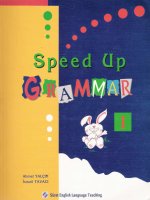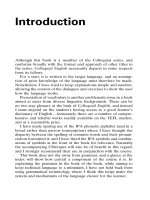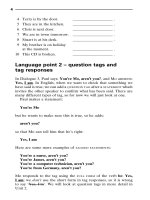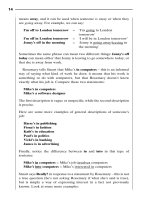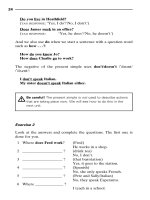ielts ''''''''international english language testing system''''''''
Bạn đang xem bản rút gọn của tài liệu. Xem và tải ngay bản đầy đủ của tài liệu tại đây (289.52 KB, 19 trang )
IELTS: 'International English Language Testing System'
IELTS BAND SCORES
IELTS band scores are used to measure your abilities in English.
There is no "pass" or "fail" with this test.
IELTS band scores are calculated from raw scores.
Let's say, out of 40 questions in the IELTS Reading section, you got 20, the number
20 would be a 5.5 band score.
The following chart shows how the IELTS band scores are calculated for Reading
and Listening.
Reading Test Listening Test
IELTS Scores
1
2
3
3.5
4
4.5
5
5.5
6
6.5
7
7.5
8
8.5
9
Raw Score
1
2,3
4,5,6,7
8,9,10
11,12,13
14,15,16
17,18,19
20,21,22,23
24,25,26,27
28,29,30
31,32,33
34,35
36,37
38,39
40
IELTS Scores
1
2
3
3.5
4
4.5
5
5.5
6
6.5
7
7.5
8
8.5
9
Raw Score
1
2,3
4,5,6,
7,8,9
10,11,12
13,14,15,16
17,18,19,20
21,22,23,24
25,26,27,28
29,30,31
32,33
34,35
36,37
38,39
40
7. Good User - understands language well, some mistakes, communicates without
many mistakes
6. Competent User - reasonable control of the language, difficulties with new
meanings
Again, your raw score is the number of answers you actually got right.
Writing Band Scores
Your band scores are based on the following
•Filling the requirements of the task
•Selecting what information to present
•Presenting a summary
•Outlining key features
•Organization of information
•Progression of the writing
•Repetition and awkward expressions
•Range of vocabulary
•Control over grammar, spelling and word choice
Examiners give you a score on these four parts.
•Task Achievement (for Task 1)
•Task Response (for Task 2)
•Understanding and Organization
•Word choice, Grammar and Accuracy
These four parts are worth 9 points each. This total is then divided by 4 to get the
band score result.
Speaking Band Scores
There are 4 things to consider:
1. Fluency and
Coherence
Do you speak fluently and how well do your
ideas work together?
2. Pronunciation
Is it correct?
3.Word Choice
How correct and varied is your vocabulary?
4.Grammar
Do you use grammar correctly and in different
ways?
The following is also important.
•Speed of speech
•Length of answer
•Pause correctly
•Expand your answers
•Answer the questions directly
•Add detail to explain your answers
•Connect your sentences
•Basic word pronunciation
•Correct sentence stress
•Have enough vocabulary to discuss a range of topics
•Use vocabulary correctly
•Be able to explain yourself when you do not have the right word
Just like the Writing Section, each part gets a score out of 9. They are added
together and divided by 4.
For example,
If you get the following scores of 7+7+6+4=24. Divide 24 by 4 and your band score is
6.
Grammar 7
Vocabulary 7
Pronunciation 6
Speaking ability 4
The Modules are taken in the following order
LISTENING
4 sections, 40 questions
30 minutes (plus 10 minutes transfer time)
READING
3 sections, 40 questions
60 minutes
(20 minutes for each reading)
WRITING
2 tasks (150 and 250 words)
60 minutes
(20 minutes for Task 1 and 40
minutes for Task 2)
SPEAKING
Personal interview with examiner.
3 Parts: about 10 to 15 minutes.
Listening Test - 4 sections, 40 questions, 30 minutes (plus 10 minutes' transfer time)
Reading Test - 3 sections, 40 questions, 60 minutes
Writing Test- - 2 pieces of writing, 60 minutes (20 min for Task 1 and 40 min for Task
2)
Speaking Test - interview, 3 parts, 15 minutes
To succeed on the IELTS, you must use your time wisely. Many students do
not finish at least one module. The table below shows how carefully students
must pay attention to the time:
Module
Total time
Questions
Time for each
question
Listening
30 min (plus 10
minutes'
transfer time)
40
.75 min
Reading
60 min
40
.67 min
Writing
60 min
2
20 min and 40
min
Speaking
10-15 min
3 to 6*
A few minutes.
* In the Speaking Part students can expect 3 questions, plus many follow-up
questions.
One more thing about Band Scores:
•An average IELTS score is around 6, but it can vary from 5.5 to 6.5.
•7 and 7.5 are very good scores.
Tips for the Test
1. In Listening, use the example at the beginning of the first section to familiarize
yourself with the sound, the situation, and the speakers.
2. Keep listening until the recording stops, looking only at the questions that
relate to the part being played.
3. There are often pauses in the recording between different sections. Use these
to prepare for the next set of questions.
4. Answer listening questions in the order they appear on the question paper.
Remember that they normally follow the order of the information in the recording.
5. At the end of the recording you have some time to transfer your answers to the
answer sheet. Check your grammar and spelling when you do this.
6. In Reading, begin by going quickly through each passage to identify features
such as the topic, the style, the source, the writer‟s purpose and the intended
reader.
7. As you read, don‟t try to understand the meaning of every word. You don‟t
have time, and these words in the text might not be tested anyway.
8. Reading tasks sometimes have an example answer. If this is the case, study it
and decide why it is correct.
9. Some tasks require you to use words from the text in the answer. In others,
you should use your own words. Check the instructions carefully.
10. The instructions may also include a word limit, e.g. “Use no more than three
words”. Pay attention to this!
11. In the Writing Section you must always keep to the topic question. Never try
to prepare sections of text before the exam.
12. In Writing, keep to the suggested amount of time for all sections.
13. In Writing, organize and link your ideas and sentences appropriately, using a
wide range of language and showing your ability (in Task 2) to discuss ideas and
express your opinions.
14. In Writing, if you write less than 150 words in Task 1 or less than 250 in Task
2 you will lose marks, but there is no maximum number of words for either. You
should write MORE than the minimum number.
15. When you plan your essay, allow 5 minutes at the end to check your work.
16. In Speaking, don‟t try to give a prepared speech, or talk about a different
topic from the one you are asked to discuss.
17. Always speak directly to the examiner, not to the recording equipment. (Look
them in the eye.)
18. Whenever you reply „Yes‟ or „No‟ to the examiner‟s questions, add more
details to your answer. In each case, explain at least one point.
19. In Speaking, remember that you are not being tested on your general
knowledge, but on your ability to communicate well.
20. In Speaking, organize and link your ideas and sentences appropriately,
talking clearly at normal speed and using a wide range of tenses and vocabulary.
“Hedging”
In multiple choice questions look for 'hedge' phrases, such as likely, may, can, will
often, sometimes, often, almost, mostly, usually, generally, rarely, and sometimes.
Question writers insert these words to cover every possibility. Often an answer will
be wrong simply because these “hedging” words are incorrect. Avoid answers that
have strong words like 'exactly', and 'always' because they may be WRONG!
Listening
The listening test measures how well you can listen for main ideas, specific
information, supporting information, facts and opinions. You will be asked a variety of
question types:
Multiple choice
Short answer
Sentence completion
Notes, diagrams, and charts
Matching
Classification
Make sure you understand the instructions and look at the example.
Instructions are both written on the question paper and spoken on the recording.
Read and listen to every word in the instructions very carefully. Make sure that you
follow them exactly and answer in the correct way.
You must also preview and predict the correct answer!
A speaker on the disc will briefly outline:
The topic
Who is talking
The situation
Fill in the Blanks Questions
Example:
Listen to the question and write in the missing information to complete the spaces.
“Irene is opening a bank account and the bank clerk is taking her details”.
Complete the following information.
Following information.
NAME: (1)_____________________
SURNAME: (2) _____________________
ADDRESS: (3) 27 ___________ Avenue,
MOTHER‟S MAIDEN NAME: (4)___________________
OLD ADDRESS: (5) 21 _______________ Road
REFERENCE Nº: (6) ______________
Tables
Here’s an example…
Countries visited
Title of the Tour book
Price of the Guide
………….(1)…………
Travels through the
Himalayas
(3)
Belgium, The
Netherlands and France
………….(2)………….
………….$14.99………….
South American
continent
Canada and Mexico:
A travelling guide
………….(4)………….
………….(5)………….
Traveling in the
Mediterranean
………….(6)………….
Tip for Tables:
If you look at the information that is given to you in the table, you will be able to
predict possible answers. If you look at the above table, the answers to column one
should be a county or area, for column two they should be a kind of book and for
column three they should be the price of the guidebook.
Here’s another example.
Complete the form below, using NO MORE THAN THREE WORDS AND/OR A
NUMBER for each answer.
Travel Wise
I N S U R A N C E C o m p a n y
Department: Car Insurance
Client details:
Name: Elisabeth 1 …
Date of birth: 9.10.1978
Address: 2 … (Avenue)
Blackwood (town)
Policy Number: 3 …
Accident information:
Date: 4 …
Time: Approx. 5 …
Supporting evidence: 6 …
Medical problems (if any): 7 …
injuries
True or False (or Not Given) Questions
Many students expect to hear the answer as it is written in the True/False statement.
Also sometimes the information is not given.
For example:
Statement:
There are five children in Joan‟s family.
CD script:
I‟ve got five children in my family.
It isn‟t likely that you will hear the answer as it appears in front of you on the question
paper, although there might be one or two easier questions like this. The people who
write the exams often put in „traps‟ to make you choose the incorrect answer. Be
careful with what is said in the recording and what is written in the question.
Pictures and Diagrams
Picture questions are often in Section 1 of the Listening Module and are multiple-
choice questions. Normally, you will see four pictures that have something in
common and there will be a written question above the pictures. You have to listen
to a conversation (usually between two people) and decide which picture answers
the written question.
Look at the example below:
“Which car has Trevor just sold?”
A B
C D
What you need to do is to „translate‟ the pictures into words. On the test, you will
have to do this in your head, but in this kind of question you can write words down
that you hear to help out.
Look carefully at the pictures and answer the question based on exactly what
you see and hear.
Also remember….
•Sometimes you need to put words in different places.
•Sometimes you have to choose a word from a list.
•Sometimes you have to match up two different lists (for example names and
addresses).
•Sometimes you have to label parts of a map or a diagram.
•Diagram questions are usually in Section 2 or 3.
A Diagram Question
Look at this example…
“It‟s a university campus. Label the parts the map from the following list”.
Here you want to listen for prepositions and phrases about location. Also pay
attention to the words given and how the answers will note these words. Also, look at
the shapes in the diagram. A “circle” could be a field and a “square” could be a
building. Remember to always try to predict your answers.
Numbers
A common problem with the listening test is you may be able to predict that you
need a number, but you have trouble understanding what the number is. Is it 13, 30
or 33? Is it 18, 80 or 88?
The only thing you can do to help with this is PRACTICE. You will have to
understand phone numbers, addresses, credit card numbers and codes.
Remember codes, reference numbers and policy numbers are quite often written
with numbers and capital letters. They should be written like this, “W3E1R6”.
Also listen for mistakes and the correction, different styles and repetition.
Fill in the Blanks Long Script Conversation
Listen to the introduction.
What you need to know.
What you need to do.
Remember:
1. Do not try to listen to every word. Instead listen for the specific information
you need. Remember you are listening for a purpose.
2. Do not worry if there is a word you do not understand - you may not need to
understand it.
3. Check that you have followed the instructions carefully.
4. If you do not know the answer to a question, move on quickly to the next
question.
5. Even if you are not certain about the answer to a question, write something.
There are no penalties for incorrect answers.
Listening Tips
The accents of the speakers on the recording are British and American.
Get used to the way letters and numbers are pronounced in British (and
American) English.
•
Anticipate general content.
•
Listen carefully.
•
Look over the questions.
•
Understand the questions.
•
Listen.
•
Check your answers.
Some expressions are used from British, rather than American English.
Learn to distinguish opinion from fact.
Follow instructions very carefully.
The questions almost always follow the oral text.
Familiarize yourself with charts, graphs, flow-charts, bar charts and pie
charts.
Reading
You will have to read three Passages and you will have about 20 minutes to read
and answer the questions for each passage so TIME is important. Each section is
quite long. Read the titles for understanding and then….
Reading Module: Academic Reading
Time
Tasks
Topics
Sources
60
minutes
Read three
passages and
answer 40
questions
General interest
topics written
for a
general
audience
Journals,
magazines,
books,
newspapers
Sample Question Styles for the Reading Section
There are many types of questions used in the Reading Section. You should be
familiar with these types.
Multiple-choice questions
Short-answer questions
Completing sentences
Completing notes, summary, tables, flowcharts
Labeling a diagram
Choosing headings for paragraphs or sections
of a text
Locating information
Identifying points of view
Identifying writer's claims
Classifying information
Matching lists or phrases
Reading Tips
Before you take the test:
1. Read as much as you can in English.
2. Keep a notebook of the words you learn.
3. Try to write these words in a sentence and put these sentences into a paragraph.
4. Learn words in context, not from a word list.
5. Know the types of questions found on the IELTS test.
6. Know the type of information asked on the IELTS test.
7. Know how to make predictions.
8. Know how to scan and look for information quickly.
During the test:
1. Read the title and any headings first. Read the introduction and the conclusion.
Make predictions about the topic.
2. Look over the questions quickly. Make predictions about content and organization.
3. Read the passage at a normal speed. Don‟t get stuck on parts you don't
understand.
4. When you answer the questions, don't spend too much time on the ones you don't
feel sure about. Make a guess and go on.
5. After you have answered all the questions, you can go back and check the ones
you aren't sure about.
6. Don't spend more than 20 minutes on each passage.
•Also you may NOT have enough time to read all of the passages from the
beginning to the end, depending on your ability. I suggest reading the
introductions and the conclusions, then read the questions and find the
answer.
Writing
The Academic Writing test is 60 minutes long. It has two writing tasks of 150 words
and 250 words.
Below are samples of Task 1 and Task 2.
Writing Task 1
You should spend about 20 minutes on this task.
For example here‟s a Task 1 sample question.
“The graph below shows the different modes of transport used to travel to and from
work in one European city in 1960, 1980 and 2000.”
Summarize the information by writing about the main ideas, and make comparisons
where they are important.
•Write at least (or more than) 150 words
•These graphs are always a “time” or “comparison” descriptive essay.
•Task 1 essay should be like this….
The introduction explains, with NO THESIS OR ARGUMENT, all the parts of the
table. It‟s a descriptive introduction. Usually, if you use the title of the table you can
write a good introduction paragraph.
The body of Task 1 explains what is fact in the table. The body should be about two
paragraphs using comparative and superlative adjectives to compare the amounts
and differences in the table. DO NOT WRITE ABOUT YOUR OPINIONS. WRITE
ABOUT THE INFORMATION GIVEN IN THE TABLE ONLY!
The conclusion is one sentence that supports what it true from the information in the
table. AGAIN, DO NOT WRITE YOUR OPINION!
Writing Task 2
You should spend about 40 minutes on this task.
For example…write about the following topic:
“It is inevitable that as technology develops so traditional cultures must be
lost. Technology and tradition are incompatible - you cannot have both
together. To what extent do you agree or disagree?”
Give reasons for your answer and include any relevant examples from your
own knowledge or experience.
•Write at least (or more than) 250 words
•Task 2 is an academic style argument.
•You NEED a thesis and you MUST argue why your OPINION or position is true,
supported by examples.
The introduction should include your thesis and 3 supporting ideas.
The body of the essay should be 3 paragraphs with each paragraph supporting one
of the points in your thesis.
You will also need a conclusion that connects to you introduction.
Very Important…
In this task, you will need to use a variety of tenses, connecting words, complex and
compound sentences, adjectives, adverbs, modifiers, and conjunctions. AND
REMEMBER THIS ESSAY IS AN ARGURMENT SUPPORTED BY YOUR
OPINION, WHICH IS GIVIEN IN YOUR THESIS!
It might be useful to make a quick outline before you begin this task. If you do, use
only a few minutes to outline your ideas.
Speaking
The speaking section is a personal interview about you, your friends and your family.
It is not a test of YOUR KNOWLEDGE about a certain topic. It is a test of your ability
to have a CONVERSATION with the tester. The Speaking Test will also be
recorded.
The Speaking Interview is about 15 minutes long, with three parts.
Part 1: You answer questions about yourself and your family.
Part 2: You speak about a topic.
Here are Some Part 2 Example Questions
Describe a situation in which you failed at something. How did you handle the failure
and what did you learn from it?
In your opinion, what is the best way to lead and motivate subordinates?
Give me the names of three famous people you admire and tell me what you admire
about them.
If you were in a job you hated, what would you do?
Part 3: You have a longer discussion on the topic from Part 2.
In Part 3 you will be given a topic card and you will be given some time, like few
minutes, to prepare your response. You can write some ideas on this card.
Tips on Speaking Part 3
Tips on Speaking Part 3
In Part 3, the interviewer will want to know how well you can ADD information on a
given topic.
Remember you will be given a card. On this card there will be a short outline of a
situation. The card will have some question that must be answered. Make sure you
answer all the questions and ADD MORE information!
You will need to ask questions to find out more information. The card will suggest
things for you to ask. So… MAKE SURE YOU ASK QUESTIONS to find out more
for the discussion.
Also, if you have your own ideas, tell them to the examiner. Remember
communication is very important in the Speaking Section!
More Tips
Here are some good expressions you could use TO ADD MORE to your answers in
the Speaking Interview:
Describe a festival event that you have attended.
You should say
•What it was
•When it was held and why
•What happened
And explain what you experienced while being there
In the future
I would like to
successfully
complete
a master's degree.
In a few
years
I'm planning to
graduate from
study at
TRU.
In two years
what I have in
mind is to
study
English.
Business.
Marketing.
In three
years
I imagine I will
receive
a BA.
an MA.
an MBA.
a PhD.
In the Speaking Section you MUST be able to…
• Provide general factual information
•Express your opinions and attitudes
•Describe a place, event or situation
•Compare places, events or situations
•You should also be able to give directions and instructions
•And you should be able to re-tell a story or a sequence of events
•Explain how or why something is done
•You will also have to be able to discuss your future plans
That’s it. Good luck on the test!
Recommended Textbook: Barron’s IELTS Test Preparation International English
$26.50 (Available at Chapter‟s in Aberdeen)
Notes prepared by Giovanni De Luca, 2011. (Permission to share granted to the TRU Writing Center c/o Anne Baker.)



